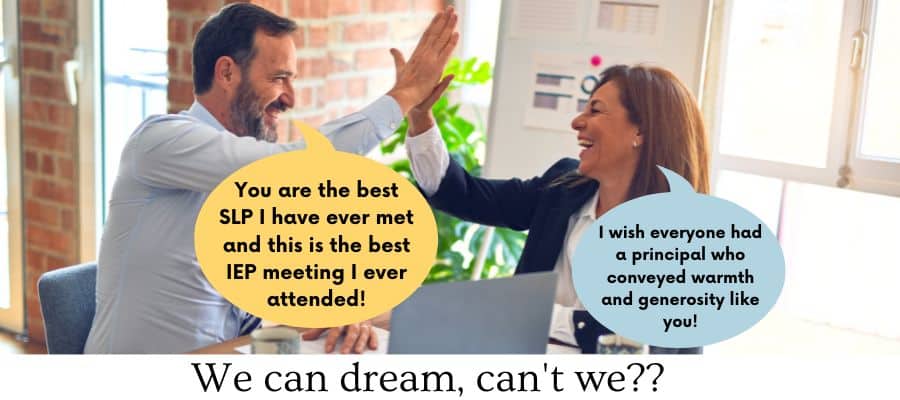The beginning of the school year and heading into the end of a school year leads us to tons of fun, interactive meetings with parents and teachers. I mean that sincerely! I love that the system gives us an opportunity to pause and meet the people we have been serving and communicating with. But I have to say that my meetings didn’t always go this way (and still don’t at times!). And there is a good reason– because these meetings are high stakes:
Individual Educational Plan (IEP) Meetings are often stressful interactions due to having to convey a new diagnosis and explain long testing timelines, as well as occasional disagreements about whether a student qualifies, and the amount of support a student is given.
It’s important to know that by their very nature these meetings can be difficult. But you know what? The family and school are lucky to have you there, pulling up your chair, and sharing your plan for meeting everyone’s needs. Secondly, these types of negotiating skills under pressure take years of experience to hone. So give yourself a break if are still working hard or happen to botch a few.
As we head into our seasons of jam-packed IEP meetings and evaluation consent meetings, I want to share five tips that members of our staff have shared for making these interactions, dare I say, fun?

1. Start your meeting by having everyone say what they love most about that student.
The credit for this idea goes to an incredible team of special educators that I worked with at KIPP. Meetings start in a variety of ways. Sometimes people know each other and are happy. Sometimes people are in a hurry. Sometimes people are angry. Sometimes there are lawyers and advocates present. Sometimes people are checked out and on their devices.
Begin your IEP meetings by leveling the playing field. Announce that you are going to start by having everyone say what they love most about the child and then you go first. This conveys that you really know the child, that you care, and that he is a human first and foremost.
Even the child with behavior issues can “bring a lot of energy to your speech sessions.”
I can’t tell you what a difference this makes:
To the parents who do not think they are there to celebrate.
To the principal who is way overworked and loves to be reminded why she got into this line of work.
To the teacher who sees you really infrequently but now sees you took the time to know the child.
It is transformative. If you do nothing more, do this one thing.
2. Use Your Data and Video to Make the Point
We have consent signed on all children we are testing so we can record their audio. We can also have consent signed for caseloads when we send out our welcome emails at the beginning of the year. It makes it It is so much fun to say something boring like:
“We want John to produce /s/ in initial, medial, and final position.”
Then whip your laptop around and say:
“Now check this out, he’s singing Sally Sells Seashells and produces /s/ perfectly a bunch of times. We are not there yet but are making progress.”
What parent doesn’t like to see videos or listen to audio of their child? Teachers too. And while principles are masterful at remembering all students’ names, they still oversee hundreds. Show them who you are specifically talking about.
This tip goes out to the Rosedale School in Austin, Texas (AISD) that serves children with severe impairments. All of our IEP meetings included video clips of things like calendar time, the library hour, the nurses helping out, parent helpers, etc. It was amazing.
3. Use Consult Time and Seek Another Diagnosis
If you are trying to dismiss in a difficult situation, using a video is a great way to prove your point. However, sometimes dismissal, even when it is the right thing to do, is not an option – YET! I don’t think SLPs take advantage of Consult Time or other diagnoses like 504 enough if they are appropriate.
When students have been in special education for a long time it can seem like a pretty sheer cliff if you are going from services to nothing. If that is not acceptable, it’s our job to be a team player and come to consensus. But also, still get the committee used to the idea that this isn’t going to go on forever.
Use the IEP meeting to reduce your student’s services by one step. If she is there for 60 minutes/week, reduce to 30. Reduce 30 to 15 or consult time. This is especially valuable in times of conflict. You say a student does not need speech but the teacher says he still needs help. They want to keep him in special education until other testing can be completed. That’s totally fine as long as you are not taking him out of the classroom but instead are consulting to make sure the student continues to progress.
4. Use Positively-Framed Language
So much of the language we are conditioned to use is negatively framed:
- Reducing services
- Dismissing from speech
- Stopping speech therapy
- Exiting
You can dramatically change the tone of your EIP meeting by saying things like:
- Returning the student to the classroom fulltime
- Ending disruptions of instructional blocks
- I heard you say he is struggling with math and reading. Well, what I am going to share is great because he will have more time to focus on that.
On this note, thank the parent for all the work that they have done. It’s a celebration!
“Mom, I know you’ve been at this speech thing for a long time. I saw that paperwork goes back to the ECI (birth-to-three) program. Oh my gosh, that’s like six years for you. You’ve done such amazing work. And that’s partly why we are able to dismiss him today. “
5. Treat the IEP meeting like a review session, not a meeting
The best IEP meetings contain no surprises. Make sure everyone understands the purpose of the meeting and results beforehand. There will always be the long meetings. But does every meeting need to take 30-90 minutes?
IEP meetings should be a review of what everyone already knows. By talking to the teacher and parent ahead of time, you also can prepare for unpredictable situations or talk to other professionals who may want to use the opportunity to sign consent based on other teacher concerns.



